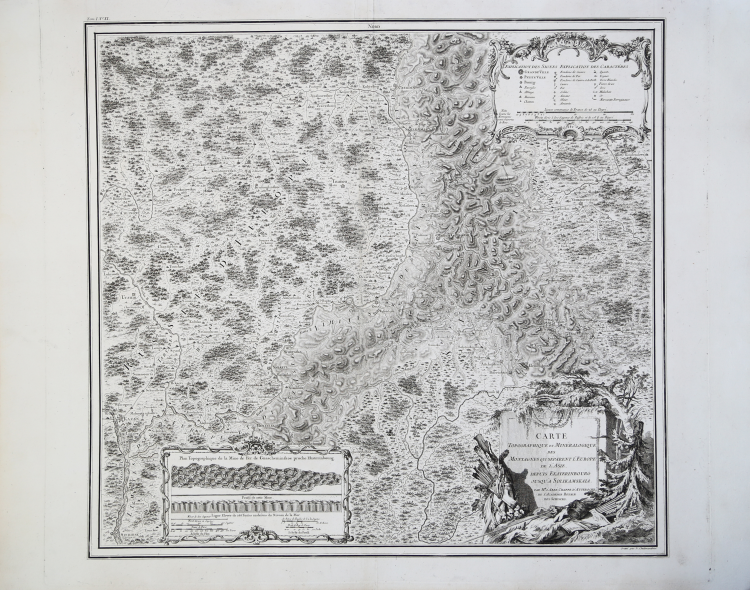



| Reference: | S42720 |
| Author | Jean-Baptiste Chappe d'Auteroche |
| Year: | 1768 |
| Zone: | Russia |
| Printed: | Paris |
| Measures: | 700 x 615 mm |


| Reference: | S42720 |
| Author | Jean-Baptiste Chappe d'Auteroche |
| Year: | 1768 |
| Zone: | Russia |
| Printed: | Paris |
| Measures: | 700 x 615 mm |
Carte Topographique et Minéralogique des Montagnes qui séparent l'Europe de l'Asie depuis Ekaterinbourg jusqu'a Solikamskaia ;par M. L'Abbé Chappe d'Auteroche de l'Academie Royale des Sciences ; Grabé par N. Chalmandrier.
Rare geological map of Urals from the famous work of Abbot Jean Chappe d'Auteroche, the Voyage en Sibérie, fait par ordre du roi en 1761; contenant Les Mœurs, les Usages des Russes, et l'Etat actuel de cette Puissance... printed in Paris, Debure, in 1768. The work consisting of three volumes of text and an illustrative atlas, contains Monsieur Kracheninnikow's description of Kamchatka. The atlas include maps of the route from Brest to Tobolsk, Russia, Kamchatka and the Kuril Islands.
Important scientific work that the abbot Jean Chappe d'Auteroche (1728-1769), a member of the Academy of Sciences, realized at the request of the latter to observe in Siberia the passage of Venus in front of the sun. He returned with astrological, mineralogical and geological records, as well as a description of Russian customs and traditions. In particular, Chappe d'Auteroche denounced despotism, which degrades the soul and enslaves man. This stance caused the fury of Empress Catherine II, who refuted the work of Chappe d'Auteroche in another that he wrote with Schouwaloff: Antidote ou examen du mauvais livre intitulé: Voyage en Sibérie.
Jean-Baptiste Chappe d'Auteroche was a French astronomer. In 1760 he was chosen by the French Academy of Sciences to go to Tobolsk to observe the transit of Venus on the Sun expected for June 6, 1761. He went by land to St. Petersburg and then in Siberia. Arrived in Tobolsk, after a tiring journey and not without dangers, at the end of April 1761 he had the opportunity to make observations that allowed him to establish the time difference between the meridian of that place and that of Paris. On June 6, 1761, after having built a small observatory, he was able to make measurements of the transit of Venus, the results of which he published in 1761 in St. Petersburg with the title Mémoire du passage de Vénus sur le soleil, avec des observations sur l'astronomie et la déclinaison de la boussole faites à Tobolsk, en Sibérie. Returning to France, he published the text Voyage en Sibérie fait en 1761, which contained descriptions of the Siberian landscape and customs and social organization of those populations that was the subject of much criticism.
Etching, in excellent condition. Rare.
Bibliography
Brunet, I-1798 / Cohen, 225.
Jean-Baptiste Chappe d'Auteroche (1728-1769)
|
Jean-Baptiste Chappe d'Auteroche was a French astronomer. In 1760 he was chosen by the French Academy of Sciences to go to Tobolsk to observe the transit of Venus on the Sun expected for June 6, 1761. He went by land to St. Petersburg and then in Siberia. Arrived in Tobolsk, after a tiring journey and not without dangers, at the end of April 1761 he had the opportunity to make observations that allowed him to establish the time difference between the meridian of that place and that of Paris. On June 6, 1761, after having built a small observatory, he was able to make measurements of the transit of Venus, the results of which he published in 1761 in St. Petersburg with the title Mémoire du passage de Vénus sur le soleil, avec des observations sur l'astronomie et la déclinaison de la boussole faites à Tobolsk, en Sibérie. Returning to France, he published the text Voyage en Sibérie fait en 1761, which contained descriptions of the Siberian landscape and customs and social organization of those populations that was the subject of much criticism.
|
Jean-Baptiste Chappe d'Auteroche (1728-1769)
|
Jean-Baptiste Chappe d'Auteroche was a French astronomer. In 1760 he was chosen by the French Academy of Sciences to go to Tobolsk to observe the transit of Venus on the Sun expected for June 6, 1761. He went by land to St. Petersburg and then in Siberia. Arrived in Tobolsk, after a tiring journey and not without dangers, at the end of April 1761 he had the opportunity to make observations that allowed him to establish the time difference between the meridian of that place and that of Paris. On June 6, 1761, after having built a small observatory, he was able to make measurements of the transit of Venus, the results of which he published in 1761 in St. Petersburg with the title Mémoire du passage de Vénus sur le soleil, avec des observations sur l'astronomie et la déclinaison de la boussole faites à Tobolsk, en Sibérie. Returning to France, he published the text Voyage en Sibérie fait en 1761, which contained descriptions of the Siberian landscape and customs and social organization of those populations that was the subject of much criticism.
|